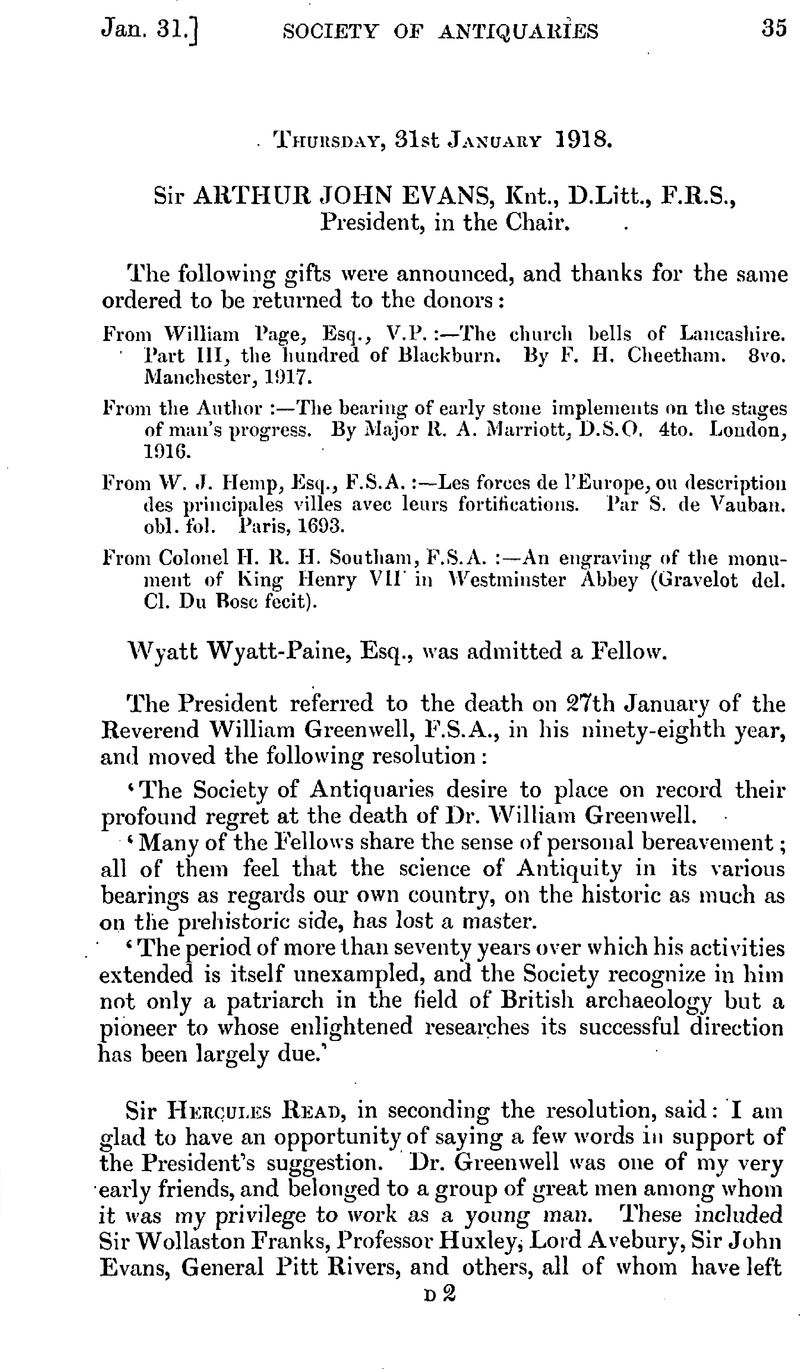No CrossRef data available.
Published online by Cambridge University Press: 10 May 2010

page 39 note 1 The work was summarized for this Society in 1774 (Archaeologia, iv, 10).
page 39 note 2 Correspondenz-Blatt, April 1901, pp. 26, 27.
page 40 note 1 Zeitschrift für Ethnologie, xxxiii, Verhandlungen (538); noticed in L'Authropologie, 1902, 640.
page 41 note 1 Correnpondenz-Blatt, Nov.-Dec. 1901, 119 (Archiv für Anthropologie, vol. xxxii); and Westdeutsche Zeitschrift, xx, 227, pl. 10.
page 42 note 1 Le Briquetage de la Seille, fouilles de 1901 (Bulletin mensuel de la Société d'archéologie lorraine, Sept. -Oct. 1901, and Dec. 1901).
page 43 note 1 Correspondenz-Blatt der Deutschen Gesellschaftfür Anthropologie, Ethnologie, und Urgeschichte, 1903, pp. 21, 29; 1904, p. 6; and Summary in L'Anthropologie, xv (1904), 617Google Scholar.
page 43 note 2 An interesting instance of this occurred near Chapel St. Leonard's, Lines., where a number of rough clay bars, pressed in the hand before firing, were found neatly arranged under what is said to be a Roman path, as well as in neighbouring dykes.
page 44 note 1 Zeitschrift für Ethnologie, vol. xxxv (1903), 642Google Scholar; summarized in L'Anthropologie, xv (1904), 479Google Scholar.
page 46 note 1 J. J. L. Ratton, Handbook of Common Salt, 81, 84, 90, 96,151.
page 46 note 2 Proceedings, xxii, 209.
page 47 note 1 Ibid., 194, fig. 15, nos. 15, 16.
page 49 note 1 Mr. Reader's comment is significant: ‘It may be well to keep in view the possibility of their having resulted from a modified form of the same industry of which the original red earth is the waste product.’
page 52 note 1 Journ. Archit. Archaeol. and Hist. Soc. Chester, i (1849–55), pp. 49, 464Google Scholar.
page 52 note 2 Proceedings, xxvi. 137., with map and four plates.
page 52 note 3 Proc. Som. Arch, and Nut. Hist. Soc., vol. i3 part ii, 57.
page 55 note 1 Archaeologia, xxx. 549, pi. xxiv; Roach Smith, Illustrations of Roman London, pi. xxi; V. C. H. London, i, fig. 47 (see p. 110).
page 56 note 1 Friends with heraldic knowledge have since informed me that this piece of harness is often found as a charge, and goes by the name of barnacles—hence the modern slang term for spectacles. ‘Breys’ is another spelling, and there are repeated representations of it in St.George's Chapel, Windsor, as the rebus of Sir Reginald Bray.
page 56 note 2 No significance need be attached to a curious resemblance to the illustration of a canoe found on the shore of Lake Neuchâtel and dating from the lake-dwelling period (Keller, Lake-dwellings of Switzerland, trans. J. E. Lee, pl. lxxxvii, figs. 3, 4, 5).
page 57 note 1 Presented by his son to the British Museum: no locality is recorded, but most of the collection was found in the city of London or in the neighbourhood of Hitchin.
page 57 note 2 Some of the brooches should date from the fourth century B. C. (Archaeological Journal, lxix, 431).
page 57 note 3 Assoc. Archit. Socs. Reports, xviii, 58, pi. iv, fig. 1.
page 59 note 1 The original catalogue describes it (no. 1260) as ‘the end of a strigil or part of the case of a curved instrument’.
page 60 note 1 Another example of this form, imperfect but originally 4½ in. long, is in the Canterbury Museum.
page 60 note 2 This and many others are figured in Hull Museum Publications, no. 65, p. 67; two views given in no. 64, pl, viii, fig. 16.
page 61 note 1 Proceedings, xxii, 139.
page 62 note 1 What seems to be a harmless example is figured by Mr. Jas. Curie in Newstead, pl. lxx, fig. 4, p. 297, and he quotes one from Hofheim (Ritterling, Nacktrag, fig. 13, no. 17666).
page 62 note 2 This connexion is practically proved by a specimen since communicated by Mr. Mead, Curator of Canterbury Museum. It is a solid crescent with loop inside, and the pointed ends turned upwards.